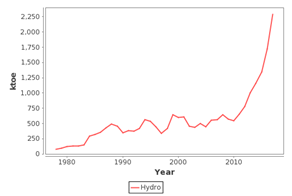International Journal of
eISSN: 2576-4454


Mini Review Volume 3 Issue 4
1Department of Biology, Faculty of Science, Universiti Putra Malaysia, 43400 UPM, Serdang, Selangor, Malaysia
2MES SOLUTIONS, 22C-1, Jalan BK 5A/2A, Bandar Kinrara, 47100 Puchong, Selangor, Malaysia
Correspondence: Chee Kong Yap, Department of Biology, Faculty of Science, Universiti Putra Malaysia, 43400 UPM, Serdang, Selangor, Malaysia
Received: July 18, 2019 | Published: August 23, 2019
Citation: Yap CK, Yap CW. Water and electricity in Malaysia: a short note. Int J Hydro. 2019;3(4):314-315. DOI: 10.15406/ijh.2019.03.00193
In our modern civilization nowadays, two of the most essential infrastructures that are usually easy to take for granted are: uncontaminated and clean Water Supply (WS) from a tap in our kitchen and Electricity Power (EP) supply with the flip of a switch that light up our entire home. Undoubtedly, WS and EP systems are backbones of civilization and they are interconnected and inseparably linked in our daily life. In short, without WS there is no EP supply. Similarly, without EP there is no WS.
Recently, in Malaysia, according to The Star Online,1 WS to three major districts in Selangor has been interrupted because of a EP cut in Seri Kembangan on March 18, 2019. The person in charge explained that the interruption of EP supply had affected several pump houses in the area to halt its function. Facing the WS shortage has caused a lot of inconvenience to the public especially to those needing clean WS to run their daily business. This is due to the fact that the EP is used in pumping for the WS to our home. The EP is needed to collect water by pumping the water from rivers or lakes, or below ground. Later, EP is needed to push the water through treatment systems, via pipes to the water treatment plant. Following that, EP is needed to push the water supply through more pipes up to a water tower. From there, the water will be pushed to our home through the gravitational power (not EP anymore).
Hydroelectric Power (HP) plants apply the falling water energy behind the dams to spin water turbines coupled to electrical generators.2 Malaysia, HP has been recommended as potential Renewable Energy (RE) resources besides biomass and solar. This is well mentioned by many citations such as Bujang et al.,3 Haiges et al.4 and Shamsuddin.5 According to Bujang et al.,3 a more aggressive way is desired to significantly counterbalance the non-RE resource such as fossil-fuel consumption. Therefore, HP is an alternative. According to Haiges et al.,4 Malaysia has adequate RE resources to cater for the projected EP demand by 2050 and fossil fuels can be fully substituted by EP generated from large HP. Moreover, HP is the leading contributor to grid-connected EP among all RE resources in the world.6
Based on Figure 1, there is a significant generation by HP from 1978 (77ktoe) to 2017 (2287ktoe) in Malaysia.2 This exhibits the importance of HP as important RE resources for now and in the future, in Malaysia. The HP has become a primary emphasis in government policies, academic research, and the energy power industry (such as TNB). The HP is considered as one of the most promising alternatives in Malaysia, as seen in the above increment of percentage for HP (Figure 1). Besides, HP is quite advantageous as it is free from greenhouse gas emissions. Ultimately, global warming effects can be reduced substantially. According to Oh et al.7 the elimination of fuel subsidy by the Malaysian government in 2014 was obligatory as an effort of its energy reform to execute a more collective EW regulatory framework. This would engage all pertinent agencies to safeguard a sustainable ES in the future.
According to Shamsuddin,5 Malaysia has large RE resources from solar energy, HE energy and biomass based energy. The most current and three major fuel mix for electricity generation based on TNB annual report of 2017. TNAR,8 is natural gas (48%), coal (31%) and HP (18%) energy, comparing to the natural gas (64%), coal (29%) and HP (7%) energy based on TNB annual report of 2008 as reviewed by Shamsuddin.5 Clearly, there is a drastic increment on the dependence of HP as a RE resource of electricity in Malaysia. This is well exemplified by the encouraging HP resources by the Sarawak Corridor of Renewable Energy which has the potential to generate 20,000MW of electricity for the country.9 The advantages of HP include having the huge storage capacity and prompt comeback features that can meet unexpected instability in EP demand.2

Figure 1 Generation by hydroelectric power from 1978 (77ktoe) to 2017 (2287ktoe) in Malaysia.2
Sustainable supply of clean water and electricity is backbones of human civilization. HP is a renewable energy resource that holds a very promising future in the energy industry in Malaysia. Since water and electricity have been indispensable devices in our modern daily life nowadays, educating the public on safeguarding our environment (stop polluting the environment) hence preserving our uncontaminated water resources is a long-term exercise. Although education can be a solution, the success rate in conserving a clean water system for the energy industry is a foreseeable challenge in the future.
None.
The author declares that there is no conflict of interest.
None.

©2019 Yap. This is an open access article distributed under the terms of the, which permits unrestricted use, distribution, and build upon your work non-commercially.